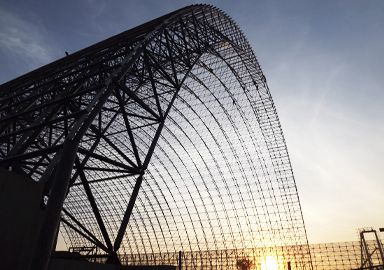The load effects in the space frame design process include dead load, live load, earthquake action, wind load, snow load, temperature effect, suspension load, operating environment, and structural weight (software automatically generates and participates in calculation). Sometimes other loads need to be considered, such as ash load, forced pull-down load caused by uneven settlement (coal bunker), traction load caused by forced deformation at the support (additional bad force caused by foundation), etc. Also consider the use of functions, hidden dangers caused by non-standard use in use, the combined load of various external conditions superimposed, the safety conditions of public buildings or industrial buildings, etc., LF also stipulates that the conditions under unstable conditions during installation should be added and many more. It is a complex process that requires extensive international experience, installation experience, design experience and judgment. According to the specification requirements and customer requirements, some also need to add experience and consideration of wind test.
Therefore, the design process is a control process of safety and manufacturing. The more considerations, the safer the structure is, but the economic efficiency will be reduced. More or less will exist. Therefore, different uses, different safety and importance determine the differences after structural design. The regulations given in the specifications must be strictly followed, but the various regulations are not satisfied individually, and systematic reprocessing and further improvement are also required.
1.Dead load
If the dry coal shed uses a metal roof, the thickness of the sheet is between 0.5-1.2mm, and the purlin uses cold-formed thin-walled components, and the overall weight is lighter.
2.Live load
The metal roof of the long-span space frame frame is a non-passenger roof. According to the “Technical Specifications for the Design of Civil Structures of Thermal Power Plants” DL5022, the live load of the non-passenger metal roof is 0.3KN/m2.
3.Bar weight and node weight
The universal design software automatically considers the weight of the members, but the weight of the nodes needs to be considered separately. The weight of the nodes of the space frame and pipe truss can be considered according to 20% to 30% of the weight of the members.
4.Catwalk weight
According to the actual situation, the horse track is converted into nodal load and applied to the lower chord layer of the structure, and the value is 2.0KN/m2.
5.Equipments weight
The self-weight of lamps, sprays and other equipment can be converted to the actual load position of the node load according to the actual situation. The specific total amount is determined by the manufacturer’s selection and the exact position of the load.
6.Snow load
The space frame structure has a large span and is sensitive to snow loads. In the design, consider the wind-induced snow migration phenomenon of the super-span and super-large area roof, resulting in uneven snow load distribution, so it needs to be adopted according to the conditions of uniform distribution of snow full span, uneven layout and half-span uniform distribution. Consider when the snow load is different from the roof live load, whichever is greater. In addition, due to the concave shape between the two spans, it is easy to accumulate snow, so this part of the snow load is considered more during design.
7.Wind load
The basic wind pressure and basic snow pressure of the roof space frame structure should be adopted according to the recurrence period of 50 years; when the cable structure, membrane structure, long cantilever structure, space space frame structure with a span greater than 120m and the roof structure are complex, the wind carrier The type coefficient and wind vibration coefficient, and the distribution coefficient of snow in the roof area (including changes during snow melting) should be appropriately increased than the specification requirements or determined by wind tunnel model tests or numerical simulation studies. “Therefore, the wind tunnel experiment should be carried out at the construction drawing stage of this modified project to determine the wind carrier type coefficient and wind vibration coefficient.
8.Seismic load
Mainly consider seismic fortification intensity, design basic earthquake acceleration value, design earthquake grouping.
9.Temperature stress
The effect of temperature on the two directions of the plane can not be ignored. The design should fully consider the possible closing period and temperature conditions of the construction. The maximum temperature difference is determined according to the local basic temperature and closing temperature, and it is considered at ±30℃.
10.Forced displacement
The design shall consider the influence of bearing settlement and horizontal displacement on the structure. The uneven settlement of the bearing is considered as 20mm, and the horizontal displacement of the bearing is considered as 20mm.



 +86-17751936871
+86-17751936871 +86-516-8595-0258
+86-516-8595-0258 marketing@lfspaceframe.com
marketing@lfspaceframe.com





